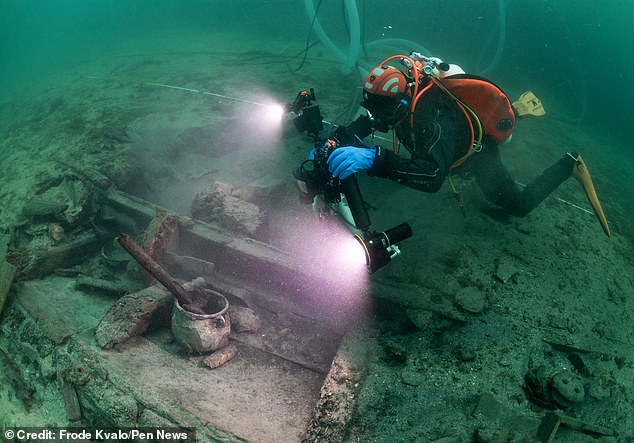A 300-year-old ship whose loss was controversially blamed on its drunken Irish crew has been found off the coast of Norway.
Divers in Mandal, in the far south of the country, thought the wreck could be the Providentz when they first discovered it in 2020.
The ship, from Cork, Ireland, is known to have sunk in the area in 1721 while sailing back to sea, with a local pilot blaming the drunken crew.
Now, new analysis has dated the wreck to the time of the sinking and revealed how the ship’s owners likely violated British Empire laws.
Archaeologist Sarah Fawsitt of the Norwegian Maritime Museum revealed that the Providentz was only two years old when it was lost at sea.
A 300-year-old ship whose loss was controversially blamed on its drunken crew has been found off the coast of Norway

Divers in Mandal, in the far south of the country, thought the wreck could be the Providentz when they first discovered it in 2020.

The photo shows a pipe with the word ‘Cork’ engraved on the side recovered from the wreck.

A cross section of a ship like the Providentz

That was the Providentz. The Providentz was bound for Arendal, Norway, with a cargo of butter, corn, grain and malt.
She said: ‘The Providentz was known to have sunk in the area so that was the first conclusion that divers from the Mandal Diving Club came to.
‘Our plan was to take some wood samples to perform a dendrochronological analysis.
‘The hope was that the year the forest was cut down would be reasonably close to the year we knew the ship sank, and no later than that date, of course.
‘When the dates on the wood were re-examined, they showed the ship was only two years old when it sank in 1721.’
It wasn’t the only clue they found.
Sarah said: ‘Before we had even taken the wood samples, two clay tubes were found in the wreck with the word ‘cork’ engraved on their sides.
“So at that point we were pretty sure it was Providentz.”
The Providentz was bound for Arendal, Norway, with a cargo of butter, corn, grain, and malt when she stopped near Mandal on 16 October 1721 to wait out the weather.

The wreck site was in Mandal, Norway.

The ship sank to the bottom of the bay in 1721.

The photo shows a hemp rope recovered from the shipwreck.

Although no one died in the initial shipwreck, the ship was apparently lost forever.
He embarked on the final leg of his journey on November 9, leaving Mandal under the guidance of a local pilot.
But the pilot confused port and starboard when giving instructions, causing the ship to run aground and a hole to open in the port side.
No one died, but the ship was lost.
After the incident, the crew blamed the pilot, and the pilot blamed the crew, saying they were falling drunk and were incapable of driving.
Fawsitt said the crew may well have been drinking, but he blamed the pilot for the confusion.
She said: ‘The crew had been waiting for more favourable weather for 13 days – it’s not unreasonable to think they had been drinking during that time.
Crossing the North Sea must have been terrifying and it is understandable that the crew wanted to let off steam when they reached safer waters.
‘My colleague, Jørgen Johannessen, has been studying this very phenomenon and has found evidence of sailors partying in other similar ports around the Norwegian coast.

A pipe with the word ‘Cork’ engraved on the side recovered from the shipwreck

Researchers from the Norwegian Maritime Museum (pictured) went underwater to investigate the wreck.

Archaeologist Sarah Fawsitt (pictured) of the Norwegian Maritime Museum revealed that the Providentz was just two years old when it was lost at sea.
But the most likely cause of the sinking was confusion between the Norwegian pilot and the crew.
“The pilot told the crew to head to starboard when he should have told them to head to port. The crew followed his instructions and crashed into the shore.”
Dendrochronological analysis of the wreck revealed another controversy.
British merchants preferred Dutch-built ships, which were designed to carry cargo rather than weapons and required far fewer crews to sail.
But the British government had made the purchase of foreign ships illegal, Fawsitt said, “in an effort to stop this flow of money out of the empire.”
However, the Providentz was built from German timber and used iron bolts, a feature of Dutch shipbuilding not yet practised in the British Isles.
This suggests that the ship’s owners, the powerful Lavitt family of Cork, broke the law at a time when Ireland was under British control.
Sarah, who is Irish, said: ‘This is a significant find as we know that at that time it was illegal to buy ships from outside the empire.

The Captain’s Rule, Recovered from the Shipwreck

The photo shows a pulley wheel, recovered from the shipwreck.

The ship stopped near Mandal on 16 October 1721 to await better weather.
‘I think the Lavitt family obtained the boat outside the law.
‘There were very strong links between Cork and the Netherlands during this period and the potential for links between the Netherlands and the Lavitt family is high.
‘Meanwhile, the possibility of British authorities identifying their ship, which is sailing from Cork to Norway, seems highly unlikely.’
She continued: ‘Given that the Lavitt family is one of the most prominent families in Cork, they would not have faced any scrutiny there.
There is also evidence that British shipbuilders had begun to copy the Dutch style of construction.
‘Therefore, it is possible that even in a port closer to the seat of British power, it may not be possible for the authorities to distinguish a British ship from a Dutch one.’
(tags to translate)dailymail


